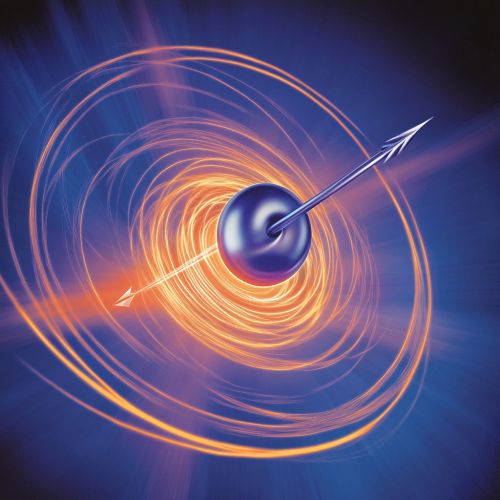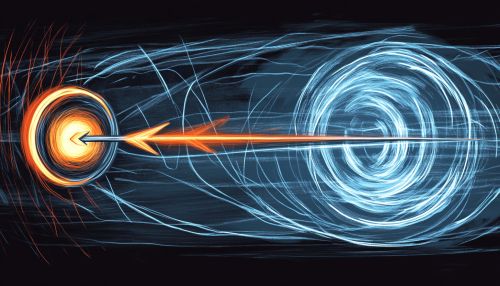Spin–orbit interaction: Difference between revisions
(Created page with "== Introduction == Spin–orbit interaction, also known as spin–orbit coupling (SOC), is a fundamental quantum mechanical phenomenon that arises from the interaction between a particle's spin and its motion. This interaction is of paramount importance in various fields of physics, including atomic, molecular, and solid-state physics. It plays a crucial role in determining the electronic structure of atoms and molecules, influencing the magnetic properties of materials...") |
No edit summary |
||
| Line 49: | Line 49: | ||
* [[Quantum Computing]] | * [[Quantum Computing]] | ||
[[Image:Detail-98487.jpg|thumb|center|An illustration of an electron with its spin represented by an arrow, moving in an electric field, with magnetic field lines depicted around it.|class=only_on_mobile]] | |||
[[Image:Detail-98488.jpg|thumb|center|An illustration of an electron with its spin represented by an arrow, moving in an electric field, with magnetic field lines depicted around it.|class=only_on_desktop]] | |||
[[Category:Quantum Mechanics]] | [[Category:Quantum Mechanics]] | ||
[[Category:Atomic Physics]] | [[Category:Atomic Physics]] | ||
[[Category:Solid-State Physics]] | [[Category:Solid-State Physics]] | ||
Latest revision as of 01:59, 16 October 2024
Introduction
Spin–orbit interaction, also known as spin–orbit coupling (SOC), is a fundamental quantum mechanical phenomenon that arises from the interaction between a particle's spin and its motion. This interaction is of paramount importance in various fields of physics, including atomic, molecular, and solid-state physics. It plays a crucial role in determining the electronic structure of atoms and molecules, influencing the magnetic properties of materials, and is a key factor in the field of spintronics.
Quantum Mechanical Foundation
The concept of spin–orbit interaction is deeply rooted in the principles of quantum mechanics. It originates from the relativistic effects that occur when a charged particle, such as an electron, moves in an electric field. According to the principles of special relativity, the motion of the electron in the electric field results in a magnetic field in the electron's rest frame. This magnetic field interacts with the electron's intrinsic magnetic moment, which is associated with its spin, leading to the spin–orbit interaction.
Mathematically, the spin–orbit interaction can be described by the Hamiltonian:
\[ H_{\text{SO}} = \frac{1}{2m^2c^2} \frac{1}{r} \frac{dV}{dr} (\mathbf{L} \cdot \mathbf{S}) \]
where \( m \) is the mass of the electron, \( c \) is the speed of light, \( r \) is the radial distance, \( V \) is the potential energy, \( \mathbf{L} \) is the orbital angular momentum, and \( \mathbf{S} \) is the spin angular momentum. The term \( \mathbf{L} \cdot \mathbf{S} \) represents the coupling between the orbital and spin angular momenta.
Atomic Physics
In atomic physics, spin–orbit interaction is responsible for the fine structure of atomic spectra. The splitting of spectral lines, known as fine structure splitting, occurs due to the energy differences between states with different total angular momentum \( J \), where \( J = L + S \). This effect is particularly significant in heavy elements, where the relativistic effects are more pronounced due to the higher nuclear charge.
The spin–orbit interaction also influences the selection rules for atomic transitions. It modifies the allowed transitions between energy levels, affecting the intensity and polarization of emitted or absorbed light. This has important implications for spectroscopic techniques used to study atomic and molecular systems.
Molecular Physics
In molecular physics, spin–orbit interaction plays a critical role in the electronic structure and dynamics of molecules. It affects the potential energy surfaces and can lead to phenomena such as spin–orbit-induced avoided crossings and conical intersections. These effects are crucial for understanding the photophysics and photochemistry of molecules, including processes like intersystem crossing and phosphorescence.
The spin–orbit interaction also influences the magnetic properties of molecules, contributing to phenomena such as zero-field splitting and magnetic anisotropy. These properties are essential for the design and understanding of molecular magnets and spintronic devices.
Solid-State Physics
In solid-state physics, spin–orbit interaction is a key factor in the electronic properties of materials. It is responsible for the splitting of energy bands, known as spin–orbit splitting, which can significantly affect the electrical, optical, and magnetic properties of solids. This is particularly important in materials with strong spin–orbit coupling, such as topological insulators and certain semiconductors.
The spin–orbit interaction also plays a crucial role in the field of spintronics, where the spin of electrons is used to store and process information. It enables the manipulation of spin currents and the generation of spin-polarized currents, which are essential for the development of spintronic devices.
Spin–Orbit Interaction in Nanostructures
In nanostructures, such as quantum dots and nanowires, spin–orbit interaction can lead to novel quantum phenomena. It can induce spin splitting in the absence of an external magnetic field, known as the Rashba effect, which is a key mechanism for spin manipulation in low-dimensional systems. The ability to control spin states in nanostructures has significant implications for quantum computing and quantum information processing.
Applications and Technological Implications
Spin–orbit interaction has numerous applications in modern technology. It is a fundamental mechanism in the design of spintronic devices, such as spin transistors and magnetic random-access memory (MRAM). The ability to manipulate spin states through spin–orbit coupling is also being explored for applications in quantum computing, where it can be used to create and control qubits.
In addition, spin–orbit interaction is being investigated for its potential in developing new materials with exotic properties, such as topological insulators and Weyl semimetals. These materials exhibit unique electronic states that are protected by the topology of their band structure, offering promising avenues for future technological advancements.
See Also
- Quantum Mechanics
- Relativistic Quantum Mechanics
- Spintronics
- Topological Insulators
- Quantum Computing


